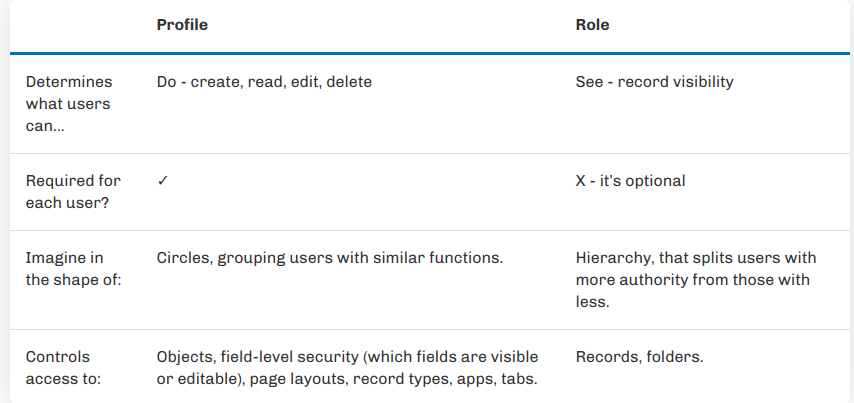What is the definition for Salesforce Profiles?
They come with a set of permissions that grant access to particular objects, fields, tabs, and records. Each user can have only one profile. Don’t give a user a profile with more access than the user needs to do their job. You can grant access to more items the user needs with a permission set.
Profiles control what users can do in your Salesforce org. This can be referred to as CRED:

You may want some users in your org to read and edit leads, but not delete them. CRED enables you to mix and match what a specific user can do with each object.

In addition to objects, profiles also control:
Field-level security (Which Fields are visible or Editable),
Apps.
The most important profile in the org is ‘System Administrator’. Users in this profile have absolute access to do anything. In addition to CRED, they will have ‘View all’ and ‘Modify all’ selected for each object.
They will also have ultimate permissions, namely ‘Modify all data’, ‘Customize application’ that you would not want to give to any other users! (found under the ‘Administrative Permissions’ section).

What is a Salesforce Role?
Users at the top of the hierarchy can see all the data owned by users below them. Users at lower levels can’t see data owned by users above them, or in other branches unless sharing rules grant them access. Roles are optional but each user can have only one. If you have an org with many users, you may find it easier to assign roles when adding users. However, you can set up a role hierarchy and assign roles to users at any time.

Difference Between Profile and Role

This salesforce role vs profile might have helped you to understand the differences. A role is controls of records a user can SEE in the hierarchy i.e. which records or objects a user can observe. This role is based on USER’s role in the hierarchy. On the other hand, a Profile is a measure of what a user can do i.e. settings of profile establish control of the visibility of objects, tabs, CRUD, fields, and functions inside an application.




